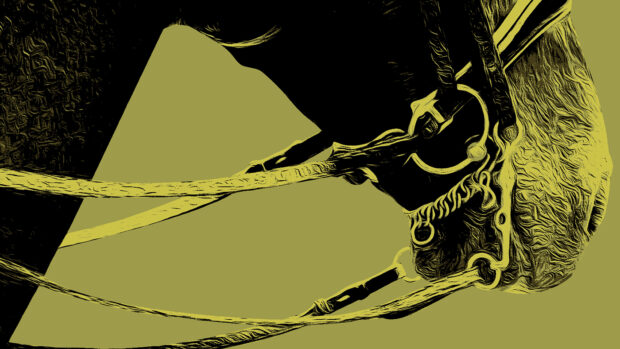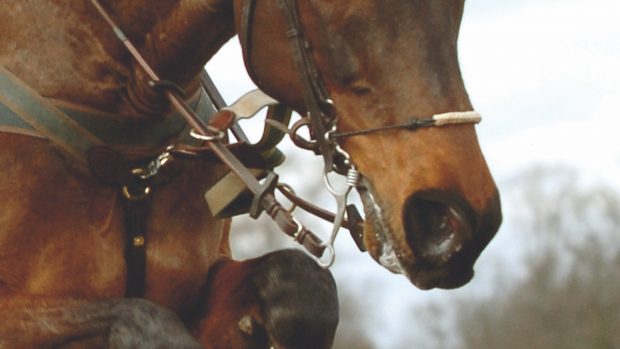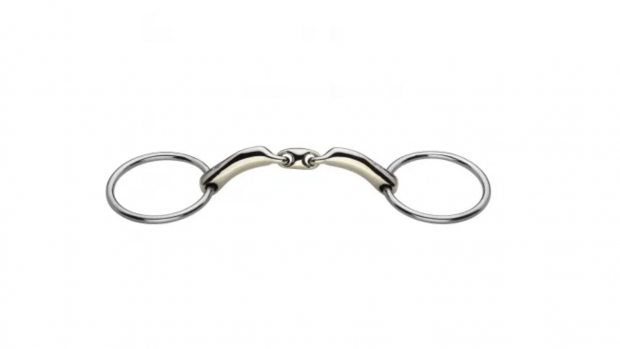Designed for horses that are difficult to lead, the Chifney bit has a reputation for being severe if used in the wrong way. We find out when and how they should be used safely
What is a Chifney bit and how does it work?
“The Chifney can either be very sharp, or very useful — depending on the handler,” says Olympic gold medallist Jane Holderness-Roddam. “We only use it on our stallions, or horses who have been mishandled.”
The Chifney, also known as an anti-rearing bit, is an in-hand bit designed for horses that are difficult to lead. The mouthpiece, a thin metal circle, loops over the horse’s tongue and behind the chin, and is attached to a sliphead, a single-strap headpiece than can be slipped on and off easily. The leadrope attaches to a single loose ring at the back of the horse’s chin.

How to use a Chifney
“The Chifney needs to be used with great care and consideration,” says Tricia Nassau-Williams, lorinery lecturer and projects manager at The Worshipful Company of Loriners. “It functions by applying an intense pressure straight onto the tongue, which means it has huge potential to cause serious damage if misused,” warns Tricia.
“Try fitting it on your arm and applying pressure as you would if leading a horse — that will give you an idea of how it would feel on the horse’s tongue and bars!”
Like standard bits, the Chifney comes in a selection of different widths and should fit in much the same way – not so low as to sit on the teeth, or so high that it wrinkles the corners of the mouth.
There are two types a mouthpiece — a straight bar and one with an inverted port.
“This indent on the mouthpiece is not designed as a tongue port, but to increase the pressure in the centre of the tongue, which is where the horse is the most responsive,” says Ema Odlin-Baxter, director at The Horse Bit Shop. As such, it can be very severe.
“The mouthpiece is curved so the sides can come down onto the bars of the mouth,” says Jane. “You need to have a soft hand with it, and be firm not sharp. For horses out of control, it is useful, but if the handler is rough with it, they can do damage.”
The Chifney was invented by jockey Samuel Chifney Snr, and patented in 1805. Samuel had hoped the Jockey Club would fund his creation — ‘a bridle that will never be excelled for their light weights to hold a horse from running away’. When the club refused, he became indebted to a loriner called Latchford and was incarcerated in Fleet Prison; he died a year later. Yet the bit he created became popular, and remains so — particularly in the racing industry.
“The British Horseracing Authority (BHA) rules that you have to use a bridle or a headcollar fitted with a Chifney when [being led] on-site at a racecourse,” says racehorse trainer Kerry Lee. “We use them on all of the horses. They’re all very well-mannered and we’ve never had a problem — though you do have to be careful as they are very sharp.”

Shires Chifney | Amazon
Available in 5in, 5½in or 6in, this Chifney is made of stainless steel, which is durable, easy to clean and tasteless.
Not a replacement for a headcollar
However, Tricia points out that, outside of the racing industry, Chifneys should never be used as a replacement for a headcollar. “Imagine if you were leading your horse in a Chifney and it took fright or panicked — if you hung on to the rope, you could do serious damage, yet if you let go, the rope could get caught in his legs and cause just as much trouble,” says Tricia.
“Some vets report cases of tongues being lacerated by the Chifney — they have to be used with extreme caution. I would only ever use one in conjunction with a headcollar, fitting it over the headcollar with a different coloured lead rope attached. That way, you are never just relying on the Chifney and can use it only when necessary.”
Much like a strong bit, once the horse feels the contact of the Chifney, they will respect it.
“I have used them successfully when handling and leading challenging horses inclined to barge, but always only for very short periods of time — such as loading or leading them to and from the field,” adds Tricia. “If they are successful, they are used once or twice and that is all that is required. If not, a Chifney is not the answer!”
Before using a Chifney, it can be well worth exploring other types of corrective halters — such as the dually halter. “I always suggest trying different styles of halters first, or perhaps a standard bit with a sliphead,” advises Ema. “However, if the horse remains unruly, it is dangerous. You need to make sure you have the horse’s respect and, if used correctly, the Chifney is an effective way to do so.”
“In my experience, horses respect them,” agrees Jane. “When you have an excitable stallion, it can lose all reason! You need something that says, ‘Hey, I’m in charge’.”

Shires Chifney | Amazon
Available in 5in, 5½in or 6in, this Chifney is made of stainless steel, which is durable, easy to clean and tasteless.
You might also like:

Choosing the right bit: would a hanging cheek snaffle suit my horse?

Choosing the right bit: would a Dutch gag suit my horse?

7 rope halters that give more precise aids for training

Leather headcollars for travelling, competing and everyday wear

Subscribe to Horse & Hound magazine today – and enjoy unlimited website access all year round
Horse & Hound magazine, out every Thursday, is packed with all the latest news and reports, as well as interviews, specials, nostalgia, vet and training advice. Find how you can enjoy the magazine delivered to your door every week, plus options to upgrade your subscription to access our online service that brings you breaking news and reports as well as other benefits.



